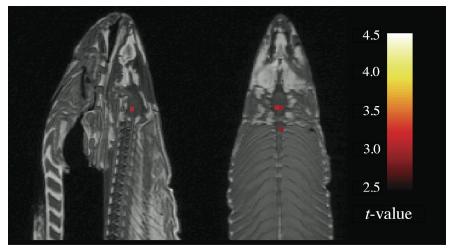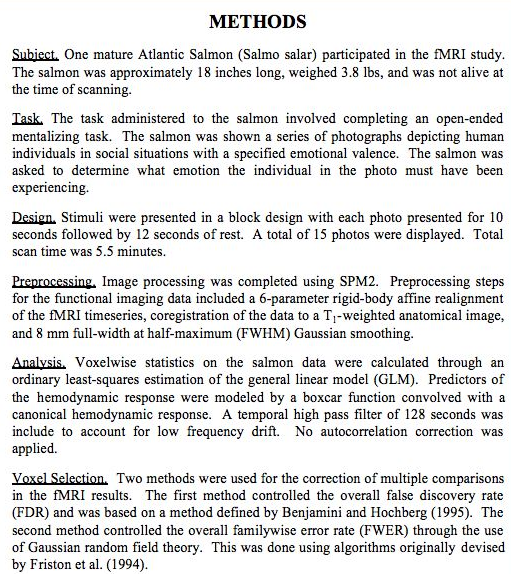Localization of emotion perception in the brain of fish
« previous post | next post »
This is beautiful work, showing that certain areas in the brain of mature Atlantic Salmon "light up" when the animal is asked to categorize the emotions expressed by a set of (human) faces:

More amazing still is the fact that the fish performed this task while dead. Specifically:

Note that SPM ("statistical parametric mapping"), the analysis software used, is pretty much the standard way of determining significance thresholds in fMRI studies.
The first author, Craig Bennett, has a blog at prefrontal.org, where you can find some further discussion, including the raw data from this experiment.
[Hat tip: Stefano Bartolo, also Neuroskeptic, who also cites a representative recent paper that fails to do the recommended multiple-comparison correction.]
David Huggins-Daines said,
September 18, 2009 @ 11:58 am
I'm surprised they didn't use a parrot instead…
greg said,
September 18, 2009 @ 12:08 pm
This is a joke, right? I must be missing something if it's supposed to be serious.
[(myl) It's completely serious. But the point is not that fish are capable of post-mortem emotion perception, but rather that there can be problems with the commonly-used techniques for determining significance thresholds for (typically very noisy) functional magnetic resonance imaging data.]
Bloix said,
September 18, 2009 @ 12:22 pm
Looks to me like this is the fish that talked to Tony Soprano.
Craig Bennett said,
September 18, 2009 @ 12:29 pm
Mark – Thank you for the kind words about the poster. I appreciate it.
David – Parrots would have been more expensive (but comedically more effective). Perhaps in a follow-up study?
Greg – The scanning was a bit of a joke, but the subsequent discussion is quite serious. You can read more regarding why we completed the experiment at the following link: http://prefrontal.org/blog/2009/09/the-story-behind-the-atlantic-salmon/
~ Craig Bennett
Spell Me Jeff said,
September 18, 2009 @ 12:49 pm
Craig, I found that same page myself. Anyone puzzled by this thread should go there. MYL's note to Greg tells the same story, but the longer version really clears it up.
Now: watch some journalist get hold of this study and convince the world that all empirical data are invalid . . . What's the signal-to-noise ratio in paleo-climatological data, for example?
Spell Me Jeff said,
September 18, 2009 @ 1:00 pm
Oh, duh. You're that Craig. Nice piece of work. If no one else wants it, try The Skeptical Inquirer. It won't help your tenure bid, but it's still a contribution.
Craig Bennett said,
September 18, 2009 @ 1:16 pm
Jeff – The journalist issue is actually one of the problems we are most worried about with this paper. Misinterpretation of the results could potentially be damaging to the research of a lot of good scientists. That is part of the reason I am on the weblog circuit this morning, responding to salmon comments.
[(myl) Yes, it would be a tragedy if the press decided to discount all functional imaging results, after years of systematically over-interpreting them.
One crucial aspect of Craig's poster was the success, in this experiment, of two standard methods of avoiding multiple-comparison false positives. So the lesson is that such corrections should be understood and used, not that all functional imaging results should be thrown away. One problem, in my opinion, in that relatively few neuroscientists are educated to understand the techniques involved — if you want to demonstrate this, just pick a couple of neuroscientists at random and ask them to explain to you what a "Gaussian random field" is, and why (and how) it can be used to set statistical significance thresholds, and what the associated caveats and pitfalls are.
Luckily (or unluckily, I'm not sure), we humans are visual critters who are fond of reductive explanations and impressed by biomedical expertise and expensive technology, and so the lure of lit-up brain regions is unlikely to be dissipated by a few dead fish. This is good news for the large amount of high-quality neuroscience research, as well as for research (or interpretation) that's more in the fish-wrap category. ]
Theo Vosse said,
September 18, 2009 @ 1:33 pm
Most of the fMRI work I witnessed involved a lot of data massaging and analysis tweaking before reaching such significance levels on blobs supporting the original hypothesis (only to be undercut by factoring in genetic markers, but that's another story). I have actually heard one researcher come into the break room, completely happy, saying that he got what he wanted, without "strangling" the data. The salmon doesn't really surprise me. I am glad the community took it well, and hope that neuro-imaging will be done more responsibly as a consequence.
Just as a precaution, we should wrap the salmon in all articles published before its demise and toss the package in the bin.
Fishy Study OTD « Buttle’s World said,
September 18, 2009 @ 1:37 pm
[…] Fishy Study OTD Filed under: Posts — buttle @ 9:38 This fMRI study is flipping brilliant. […]
greg said,
September 18, 2009 @ 2:06 pm
@mark & craig – ah. I didn't have the time to go poking around for more information that was originally presented here, and I'm not familiar with fMRIs or the language used when discussing information generated by them, so I couldn't puzzle it out. Thanks for the clarification.
ArthurDent said,
September 18, 2009 @ 4:15 pm
Did you eat the salmon, I hope? Did you still get positive results after it became sashimi?
Craig Bennett said,
September 18, 2009 @ 4:49 pm
Jeff – We might have to look into the Skeptical Inquirer. We already got an invitation from the Annals of Improbable Research, so at least we have that to fall back on. Maybe it would be competitive for an Ig Nobel award?
Mark – I love your point regarding 'over-interpretation' by the press. Your argument about researchers understanding the methods they are using is also quite sound. Many individuals are simply taught what buttons to press in SPM instead of obtaining a working knowledge of how each step is completed. I wholeheartedly believe that increasing the awareness of statistical issues will be an important step in advancing the field. With any luck the salmon results will achieve some progress in that regard.
Theo – You actually just described one of my greatest pet peeves in imaging. I have seen some researchers conduct several contrasts on the data to investigate their hypotheses and then proceed to threshold those contrasts at different levels to obtain a desired or 'clean' result. They will then proceed to compare the two results as if they were equivalent.
Arthur – We did eat the salmon later that night. We had to store it in the snow outside the imaging center for ten hours while we scanned, but it didn't seem worse for the experience. In fact, I would go so far as to say it was delicious.
Sili said,
September 18, 2009 @ 5:54 pm
I'd suggest someone do fMRI of cows with dialects, but I guess one'd need a full-size scanner for that (come to think of it, the rat-scanners must be too small for salmon too).
I wonder if one could actually do work on a live salmon. I'd think the water in the tank with be a source of noise.
Neuroskeptic said,
September 19, 2009 @ 5:52 am
I agree with Craig about the potential of over interpreting this result – I haven't seen anyone do that yet, actually, but it's a worry. It happened with Ed Vul's "voodoo" paper, for example, which was reported as casting doubt on the whole of social neuroscience (or even the whole of fMRI) when in fact it was a valid criticism of some, but by no means all, methods used in a minority of papers.
I also agree completely with his concerns about fMRI researchers being taught to push buttons instead of understanding the issues. There are now several excellent fMRI analysis software packages (FSL,SPM,BrainVoyager) which make fMRI analysis very easy, unfortunately, they make bad analysis even easier.
Ideally there would be some kind of fMRI school where you take exams to get a license to scan brains. I genuinely think that would help. However that's not going to happen really… A good second-best would be a set of guidelines for best-practice on reporting fMRI data which all published papers would have to adhere to (e.g. you have to report both uncorrected and corrected data, you have to report whole-brain as well as ROI, you have to show that you have avoided Ed Vul's non independence error).
Finally, the paper I linked to was just a random example, by no means any worse than many others. And to be fair to the authors they do report corrected results in some of their analyses – but they also report uncorrected ones, in a slap-dash manner.
Theo Vosse said,
September 19, 2009 @ 12:52 pm
Craig, if you scan two salmons and correlate the results to a difference in their genetic make-up, you can send it to Nature…
Vicki Baker said,
September 20, 2009 @ 4:30 pm
If this doesn't get an Ig Nobel, I'm a be very disappointed.
The Chemist said,
September 21, 2009 @ 3:16 pm
I'm curious. How do you ask (TASK) a dead salmon something? And, why was only one salmon used in this study?
Craig Bennett said,
September 21, 2009 @ 6:08 pm
Neuroskeptic – That is a provocative idea, the notion of requiring a license to conduct fMRI investigations. I mean, we already require our MRI technicians to be certified, so why not the researchers? I suppose that, ideally, graduate school is meant to be this kind of training. I spent five years working with fMRI and learning about it while I was at Dartmouth. I came away from this experience with a rather thorough knowledge of how to conduct imaging studies. I believe that the major hurdle is, as you suggested, the ease with which you can push the buttons. Some researchers are still using a canonical processing script that may have been written a decade ago when SPM99 was de rigeur. Times have changed, methods have changed, and we argue that statistical standards should change as well.
Theo – Given the magnitude of the multiple comparisons problem when you combine 130,000 functional imaging voxels with 500,000 SNPs from a microarray I have no doubt that we would be able to find something at p < 0.001 with an eight voxel extent. ;)
Chemist – We were doing the final rehearsal for human scanning when the salmon was in the scanner. Because of this we did everything as if we had a human subject in the magnet, including giving task instructions.
Linkblogging for 22/09/09 « Sci-Ence! Justice Leak! said,
September 22, 2009 @ 3:41 pm
[…] And possibly the best scientific paper I've heard about in a long while. […]
Interlude: Language Log « said,
March 26, 2010 @ 12:19 am
[…] burn up many Internet hours perusing articles about embarrassing spell-checker miscorrections and dead fish brains' documented reactions to human facial expressions. Oh yes, it is truly a beautiful […]